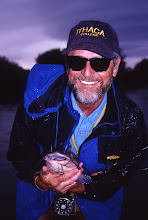Cry Havoc and let slip the dogs of war so sayeth the Bard. Little did he know he was describing my favorite Pacific salmon. However it’s clear that my favorite salmon is attracting much (some would say way too much) attention from the gillnetters and purse seiners.
Here’s an excerpt from an article I wrote for Fly Fusion
Commercial Pressure
Chum have historically been Washington’s most abundant naturally reproducing salmon with fish classed as summer (spawning September/October), fall (spawning November/December) and winter (spawning January/February) run fish. In Puget Sound, roughly 90% of the returning fish are fall run, though the summer and winter fish provide a nice biological mix. In years past the chum was the least desirable commercial salmon, but that has changed, at least in Washington’s Puget Sound with as yet known consequences to the fish stocks. According to an article in Pacific Fishing, “In Puget Sound, chum has become THE salmon fishing for many fisherman.”
The switch to chum is driven by market price. Five years ago Puget Sound commercial fishers were hard pressed to find buyers for any fish they caught. Now they get upwards of a $1.00 per pound from high-end retail buyers. Chum roe, the only valuable part of the fish a few years ago, fetched $10 to $12 a pound, double the price from 2007.
How much pressure are the commercials placing on the resource? In November 2008, there were almost 75 seiners and 200 gillnetters chasing chum throughout Puget Sound. Mother Nature can stress a fish population as well. December 2008 found the Puget Sound blanketed in record snowfall that flooded many river systems when melted by the Pineapple Express rains. The flood scour damage to redds will only be known when the 2009 age class return three to five years hence.
I’m generally a catch and release salmon fisher so bag limits typically mean nothing to me. However, I’m extremely concerned about the future of the fishery. Take a look at the 2010-11 regulations for the Skagit, Snohomish and Skykomish rivers. These historically are chum rivers. Take a look at the Chehalis system. Note that no chum may be retained by sports anglers.
Here’s a two-part suggestion. First, don’t bash WDFW–it doesn’t do any good and it wastes your energy. Second, express your concerns to WDFW in a positive, constructive manner, get involved in the citizens advisory groups, get educated about the North of Falcon process and hammer on your legislators about the disparity of value between a commercial caught fish and sports caught fish. Suggest to your legislator that the allocation of fish between the commercial and sports anglers must be reversed if only because it makes better economic sense
skip to main |
skip to sidebar

Northwest Fly Fishing Blog
http://blog.seattlepi.com/flyfishing/
The Williams Lawfirm
http://thewilliamslawfirm.com/
About Me

- The Fishing Writer
- First fly-caught fish was a trout on a Brown Bivisible 50 years ago. Aside from some years foolishly spent playing golf, I've been fishing ever since.